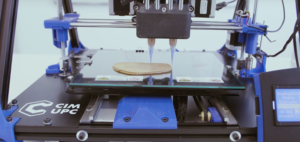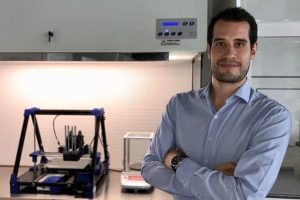 Meat. Millions of people demand it. Global meat consumption has increased by 70% since the 1960s and is expected to keep on growing, while total production has grown five times in the same period. But experts are advising that if we keep moving along this path, the environmental footprint of raising livestock for meat consumption will be too much of a burden for the planet to bear. We already know that raising animals for food consumes more than half of all water used in the US alone, while producing just one hamburger uses enough fossil fuel to drive a small car 20 miles, and a typical pig factory generates the same amount of raw waste as a city of 12,000 people. Many people have begun tackling the issue, attempting to transform the way we produce and consume meat in the next decade. The meat substitute market has attracted people looking for an alternative for quite a few years, but now, thanks to the food 3D printing industry, the segment is expected to grow even more as they begin to offer high quality, bespoke products that could become a breakthrough in innovation and substitutes for meat-eaters.
Meat. Millions of people demand it. Global meat consumption has increased by 70% since the 1960s and is expected to keep on growing, while total production has grown five times in the same period. But experts are advising that if we keep moving along this path, the environmental footprint of raising livestock for meat consumption will be too much of a burden for the planet to bear. We already know that raising animals for food consumes more than half of all water used in the US alone, while producing just one hamburger uses enough fossil fuel to drive a small car 20 miles, and a typical pig factory generates the same amount of raw waste as a city of 12,000 people. Many people have begun tackling the issue, attempting to transform the way we produce and consume meat in the next decade. The meat substitute market has attracted people looking for an alternative for quite a few years, but now, thanks to the food 3D printing industry, the segment is expected to grow even more as they begin to offer high quality, bespoke products that could become a breakthrough in innovation and substitutes for meat-eaters.
Novameat, a Barcelona-based startup, wants to undertake small scale meat-substitute production using its own patented technology. In 2018 the company developed the first 3D printed plant-based steaks. The project will see commercial light in 2020 when the company launches its own meat-substitute producing system, which includes a customized printer that will enable companies to create tissues needed to make beefsteak.
The core of Novameat’s technology is based on Giuseppe Scionti’s decade-long tissue engineering research, which he uses to mimic the texture, taste, appearance and nutritional properties of animal meat products, using all-natural ingredients of non-animal origin. During an interview with 3DPrint.com, Scionti, the founder and CEO of Novameat, suggested that his unique approach to 3D printing food is what differentiates the technological end product he will release next year.
“Novameat didn’t start like other companies. The origin was biomedicine, which means we have a different perspective on the food industry and are able to create something new. Before the startup, I was developing tissues at the lab and later a technology that allowed me to create product that had the texture and appearance of animal tissue,” said Scionti, an Italian biomedical engineering expert and former assistant professor in bioengineering at the Polytechnic University of Catalonia (UPC) in Spain.
Achieving an ideal taste together with a perfect texture is very complex, claims Scionti. So the novelty is that he went on to use a tissue engineering strategy to create a plant-based meat substitute with efficiency in terms of time and cost, while the company’s microextrusion technology allows users to get a customized 3D structure.
“We met up with many chefs from some of the top restaurants in Barcelona, and they are usually surprised at the potential of the technology, especially since it allows to construct a product with incredible texture, similar to meat, but with plant-based ingredients, something that would allow them to develop their own prototypes”.
Existing plant-based meat producers have already managed to replicate ground meat, and with quite favorable results; however, generating plant-based meat substitutes of animal fibrous meats, like steaks, is not that easy – the texture is different and the taste even more so. Other companies, like Impossible Foods, are already commercializing plant-based meat products but are only presented as hamburgers or meatballs, as they are unable to imitate the texture of a steak. Still others are using cultured meat grown inside the lab from animal-cell cultures to generate their product, although this is quite expensive.
Scionti explains that his technology would be useful to restaurants and even hospitals that are searching for new ways to develop bespoke meat substitutes with the customized nutritional elements required by patients. But the dream doesn’t end there: he also believes Novameat would do great in space. It’s still a long term project, but Scionti imagines a future in which small containers with protein and water can be regularly transported to space stations for on-site production of vegan meat.
Although he’s not there yet, the actual microextrusion technology prototype being used at the company’s headquarters takes in vegetable fat (3%), water (72%), and plant protein sources (25%) to print a meat fiber matrix that mimics the texture and flavor of real meat. Scionti and his team test the technology every day as a way to keep working on their final product, which will be released next year. But before that, they still need to focus on the flavor and nutritional properties, something they plan to do in the next six months.
“The raw material for the steak comes from pea or rice protein, which is only the starting point. To obtain all the properties we want in our beefsteak, we then incorporate natural coloring and seaweed fiber,” explained Scionti.
The researcher spent the last few years at the UPC developing the technology behind the startup and later partnered with CIM-UPC, a Barcelona-based 3D printer manufacturer, to develop the system. The short-term goal for the company is to expand in small scale locations – basically restaurants, hospitals, and supermarkets that need to produce the meatless steak for their customers on-site. However, in the long haul, they expect to target clients in industrial-scale meat production.
“We are starting to develop a new system for industrial scale no-animal meat production. We hope to offer it to plant-based meat producers, and will be similar to the machines they already have, but with certain modifications. The current industrial machines are rather harsh, and can only use soybean or gluten wheat to make the product, however, we expect our system to allow for different input ingredients and the ability to transform the end product, giving it a different look or design.”
This industrial-scale project will use Novameat’s technology to make production more efficient; however, the end product will not be a customized steak. That will only be available using their small-scale 3D printing system. In each endeavor, Novameat will grant its customers control over the ingredients and mixtures that go into the end product, enabling innovations thanks to customizable gastronomical categories that will be available once they purchase the technology.
Located at the Research Centre for Biomedical Engineering at UPC, the company expects to further develop its platform by accelerating the production of other meats, such as chicken, pork and salmon, although Scionti is still not sure which one he will tackle next. The startup is funded by New Crop Capital, a global investor specializing in proteins that will change the way we eat in the future.
“Thanks to these new alternatives, I consider we can have a great impact on the environment, human health and animal welfare. The current intensive livestock system is counterproductive, it uses too much water, contaminates and consuming red meat regularly increases the chances of colon cancer by 15%. So we need to find a more efficient way to feed a growing population with our limited resources and find a product for the increasing demand of meat substitutes, which in Europe has grown 450%,” concluded Scionci.
 The futuristic and ethical approach to the meaty texture of Novameat’s plant-based product is at the core of Scionti and his team’s worki. And who knows what they will try to imitate next – it could be pork or salmon, both of which are very interesting and in-demand proposals. But whatever they choose, we can expect high standards and an interesting gastronomical proposal from this startup. Would you try it?
The futuristic and ethical approach to the meaty texture of Novameat’s plant-based product is at the core of Scionti and his team’s worki. And who knows what they will try to imitate next – it could be pork or salmon, both of which are very interesting and in-demand proposals. But whatever they choose, we can expect high standards and an interesting gastronomical proposal from this startup. Would you try it?
Subscribe to Our Email Newsletter
Stay up-to-date on all the latest news from the 3D printing industry and receive information and offers from third party vendors.
You May Also Like
Why Corrosive Resistant Materials Are Important to the Success of 3D Printing Across Industries
The adoption of additive manufacturing (AM) is accelerating across many major industries. As this technological shift unfolds, the importance of corrosion resistance has emerged as a challenge for 3D printing...
America Makes Announces IMPACT 2.0: $6.6M in New 3D Printing Funding
America Makes, the Manufacturing Innovation Institute (MII) based in Youngstown, Ohio, has announced IMPACT (Improvement in Manufacturing Productivity via Additive Capabilities and Techno-Economic Analysis) 2.0, a project call which will...
3D Printing Webinar and Event Roundup: April 14, 2024
We’re starting off the week’s 3D printing webinars and events at ASTM AMCOE’s 11th Snapshot Workshop and MACH Exhibition. Stratasys continues its advanced training courses, SME is holding a virtual...
AMUK Welcomes Airframe Designs as British 3D Printing Industry Grows
While the UK is not the hub for 3D printer and materials manufacturers as other nations, the country continues to excel at the research, development, and application of additive manufacturing...


































